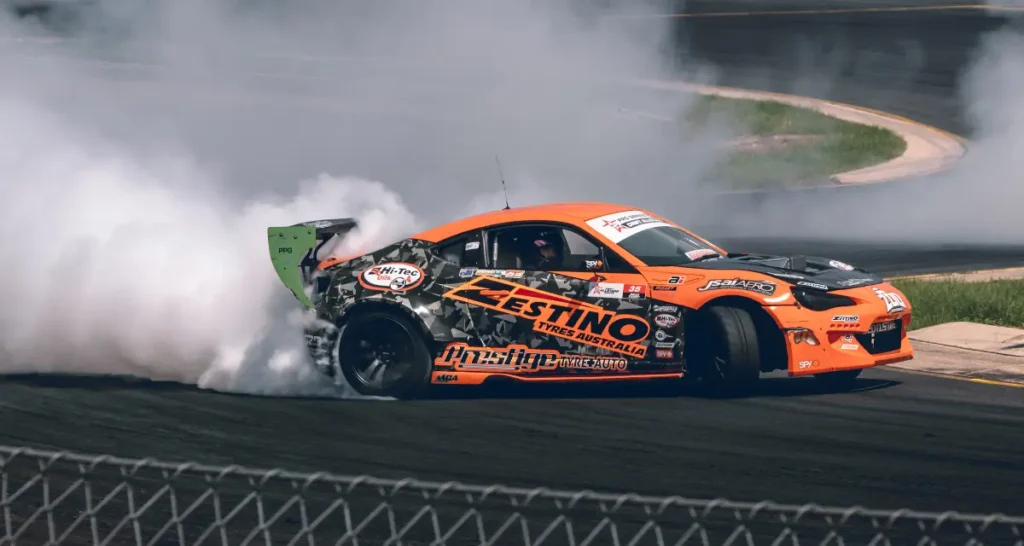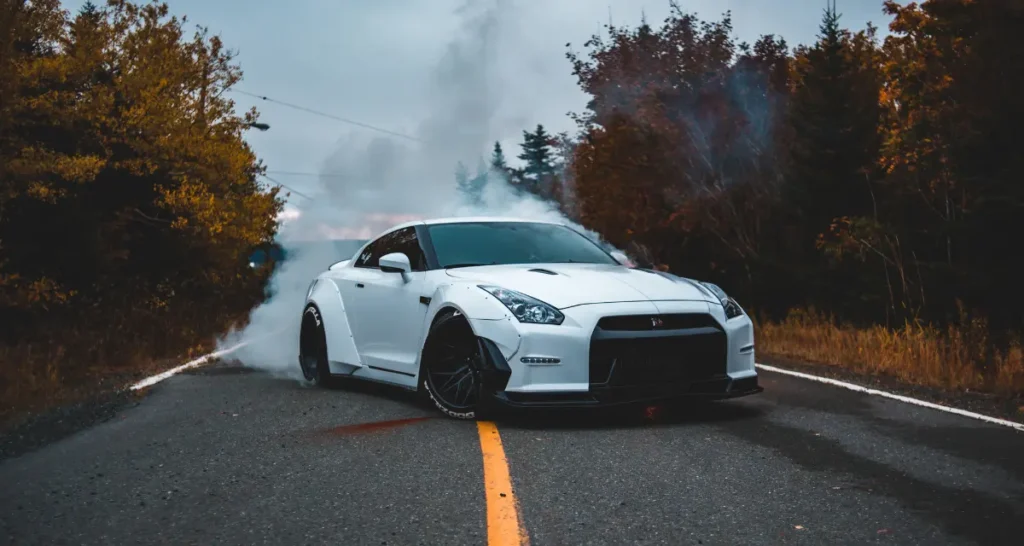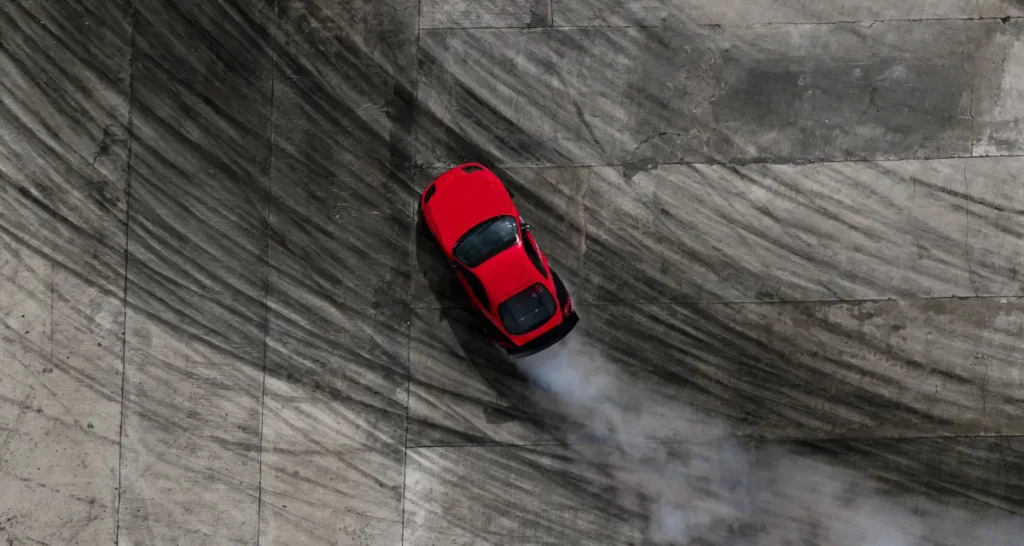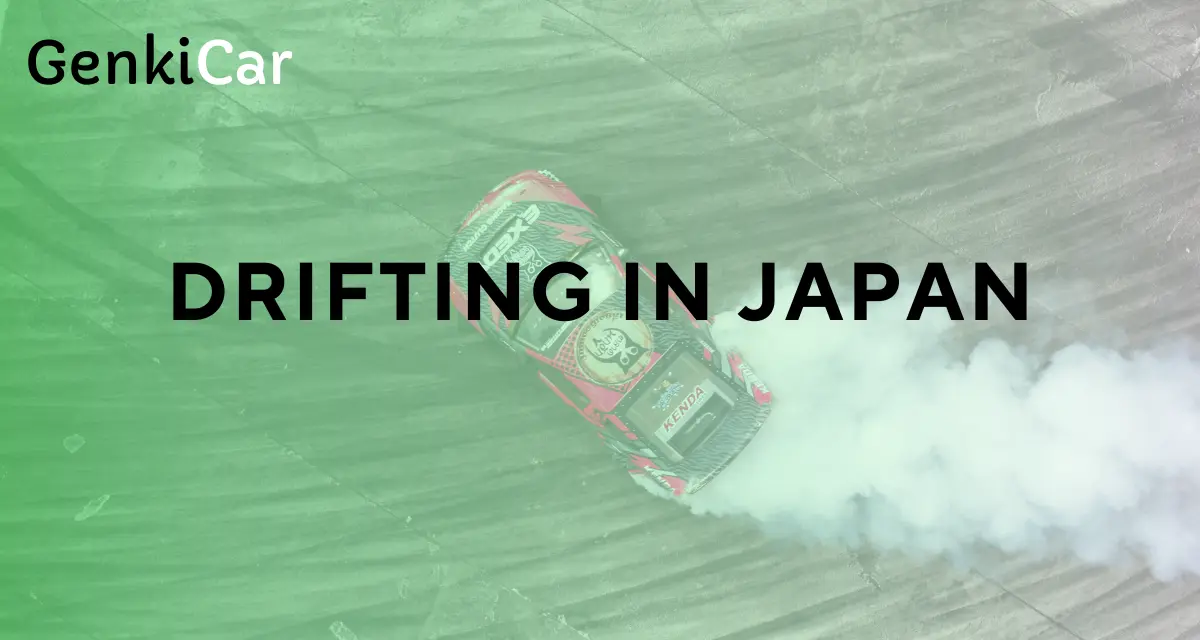Drifting in Japan traces its roots to the late 1970s, where motorcycle racer Kunimitsu Takahashi first introduced the concept of controlled oversteering. Initially, Takahashi used this technique in the world of motorcycle racing, but it wasn’t long before it found its way into car racing, where it began to capture the attention of enthusiasts. The winding mountain roads in Japan, known as touge, became the perfect environment for early drifters to practice and refine their skills. These challenging roads pushed drivers to master the art of car control, and as the technique grew more popular, it became a hallmark of Japanese motorsport.
How Drifting Became a Global Phenomenon?
Drifting in Japan, it didn’t stay confined to the island for long. In the 1990s, the sport began to gain recognition outside Japan, thanks to the increasing coverage of Japanese motorsports and the rise of drifting competitions. The spread of the sport accelerated, with international drivers visiting Japan to learn from the best. It wasn’t just the races that drew global attention, but also the unique style and technique that set drifting apart from other motorsports. The ability to slide a car gracefully around a corner became a point of fascination for motorsport enthusiasts worldwide.
Drifting in Japan wouldn’t have achieved its current status without the legendary figures who pioneered the sport and inspired generations of drivers. From the early days of illegal street racing to the professional circuits, these drifters have shaped the sport and its cultural significance both in Japan and globally.
Evolution of Japanese Police Cars – Learn how Japanese police vehicles have evolved over time and their significance in the country’s automotive culture.
Kunimitsu Takahashi – The Man Who Started It All
Kunimitsu Takahashi is widely regarded as the father of drifting. In the 1970s, Takahashi’s aggressive racing style and ability to control his car while sliding through corners laid the foundation for what would later become known as drifting. He initially demonstrated this technique in motorcycle racing before applying it to car racing, where it gained traction. Takahashi’s pioneering efforts in both developing the technique and showing its potential to audiences paved the way for the next generation of drifters. Without his vision, drifting might never have made its mark on the motorsport world.
Keiichi Tsuchiya – The “Drift King” and His Impact
Keiichi Tsuchiya, also known as the “Drift King” (Dorikin), is perhaps the most iconic figure in the history of Japanese drifting. Tsuchiya’s journey began on the touge roads of Japan, where he honed his drifting skills through illegal street racing. In the 1980s, he became known for his spectacular drifting performances, and his raw, fearless driving style earned him the respect of both fans and fellow drivers. Tsuchiya played a crucial role in bringing drifting to the mainstream, both as a driver and as a mentor to future champions. His appearances in drifting competitions, as well as his contributions to the anime Initial D as a technical advisor, helped further popularize the sport worldwide.
Modern-Day Japanese Drifting Legends
While Takahashi and Tsuchiya remain the bedrock of drifting’s history, modern-day Japanese drifters have continued to push the boundaries of the sport. Drivers like Daigo Saito, known for his aggressive yet calculated style, have made a name for themselves on the international stage. Saito’s dominance in the D1 Grand Prix and his victories in global drifting events have earned him recognition as one of the sport’s top talents. Similarly, drivers such as Masao Suenaga and Nobushige Kumakubo are also well-regarded in Japan and internationally, continuing to showcase the incredible skills and innovations that make Japanese drifting a thrilling spectacle.
Curious about buying a car in Japan? Read our detailed Ultimate Guide to Buying Cars In Japan As a Foreigner.
What Are the Best Cars for Drifting in Japan?

Toyota AE86 – The Legendary Drift Machine
The Toyota AE86, also known as the Sprinter Trueno or Corolla Levin, is widely regarded as the quintessential drift car. This lightweight, rear-wheel-drive compact car has achieved near-mythical status, especially in the drifting community. The AE86 is beloved for its perfect balance, affordability, and ease of modification. Its portrayal in the anime Initial D, where protagonist Takumi Fujiwara uses the car to dominate mountain races, cemented its iconic status. The car’s high-revving 4A-GE engine, responsive handling, and customizable nature made it the go-to choice for drifters in the 1980s and 1990s, and it remains a beloved figure in the sport to this day.
Nissan Silvia and Skyline – The Go-To Choices for Drifters
Nissan’s Silvia and Skyline have long been favorites in the drifting world due to their exceptional handling and aftermarket modification potential. The Nissan Silvia, in particular, with its lightweight body and rear-wheel-drive setup, offers unparalleled balance and precision, making it a prime candidate for drifting. Models like the S13, S14, and S15 Silvia have been widely used in professional competitions, and their legendary status is further cemented by their success in drifting events like the D1 Grand Prix.
Similarly, the Nissan Skyline, particularly the R32, R33, and R34 generations, has a strong following among drift enthusiasts. Known for their advanced engineering and strong engine performance, these cars offer superior handling and a platform for serious tuning. Their versatility allows drifters to push the boundaries of what’s possible on the track, making them a staple in Japan’s drifting scene.
Mazda RX-7 and Other High-Performance Drift Cars
The Mazda RX-7, with its unique rotary engine, is another legendary car that has left a mark on the drifting scene in Japan. Known for its low weight, exceptional cornering ability, and distinctive engine sound, the RX-7 is a popular choice among drift enthusiasts looking for a car that stands out. The FD3S model, in particular, is highly regarded for its perfect balance and responsive rear-wheel-drive dynamics, making it ideal for controlled sliding around corners.
In addition to the AE86, Silvia, Skyline, and RX-7, other cars such as the Toyota Supra, Nissan 350Z, and Subaru BRZ have gained traction in drifting competitions. These cars offer excellent performance, with tunable engines and suspension systems that allow drivers to adjust them for optimal drifting performance. While each car has its own unique attributes, the best drift cars are those that offer a combination of power, balance, and precision handling.
Where Are the Top Places to Experience Drifting in Japan?

Drifting in Japan, and it offers a variety of locations where enthusiasts can either spectate or actively participate in this adrenaline-pumping sport. From dedicated racing circuits to iconic mountain roads, Japan is full of places that celebrate the culture and artistry of drifting.
Ebisu Circuit, Fukushima – The Holy Land of Drifting
The Ebisu Circuit, located in Fukushima Prefecture, is considered the holy land of drifting. This iconic motorsport venue is synonymous with the sport and holds a special place in the hearts of drifters worldwide. The circuit offers a series of tracks designed specifically for drifting, including tight corners and high-speed sections that test even the most skilled drivers. Ebisu is known for its welcoming atmosphere, where both beginners and seasoned pros can experience the thrill of drifting on a professional track.
Not only is Ebisu home to the D1 Grand Prix and various other drifting events, but it also serves as a training ground for drifters of all levels. The legendary “Drift Paradise” section of the track is particularly popular, attracting drifting enthusiasts from across Japan and the world. The Ebisu Circuit’s impact on drifting culture has made it a must-visit destination for anyone serious about the sport.
Famous Touge (Mountain Pass) Drift Spots
While professional drifting tracks like Ebisu offer controlled environments for drifting, Japan’s touge (mountain passes) hold a special place in the sport’s history. These narrow, winding roads carved into the mountainsides were once the battlegrounds for illegal street racing, where drifters honed their skills in secrecy. The most famous of these mountain roads include the Akina Pass (featured prominently in Initial D), the Usui Pass, and the Hakone Turnpike.
The touge roads offer a more raw and unforgiving drifting experience, where drivers must master the art of handling their vehicles in tight corners, unpredictable road conditions, and elevation changes. Though these roads are now largely off-limits to illegal street racing, they remain a key part of Japan’s drifting culture and are revered by enthusiasts who appreciate the sport’s humble beginnings.
Professional Drift Events and Competitions in Japan
For those looking to see top-tier drifting in action, Japan offers a wealth of professional drift events and competitions. The D1 Grand Prix (D1GP), which started in 2000, is the premier professional drifting series in Japan and one of the most prestigious events worldwide. Held annually at various locations across Japan, D1GP brings together the best drivers from around the world, including some of the most renowned figures in the sport.
In addition to D1GP, other events like Formula Drift Japan and local grassroots competitions offer opportunities for fans to watch talented drifters showcase their skills. These events typically feature a mix of qualifying rounds, tandem battles, and freestyle drifting, providing a thrilling spectacle for spectators. Many of these events are held at large circuits such as Fuji Speedway and Twin Ring Motegi, which are equipped with professional-grade tracks designed for drifting.
Attending these events is a fantastic way to witness the intensity and excitement of drifting firsthand, and it gives fans a deeper appreciation for the technical skill required to master the sport.
How Can You Try Drifting in Japan as a Tourist?

For those looking to experience the thrill of drifting firsthand, Japan offers several options that allow tourists to try the sport in a controlled and safe environment. Whether you’re a complete beginner or an experienced motorsport enthusiast, there are a variety of opportunities to get behind the wheel and experience drifting like a true Japanese driver.
Drift Schools and Driving Experiences for Beginners
One of the best ways to get started with drifting in Japan is by enrolling in a drift school or participating in a driving experience. These schools offer professional instructors who can teach you the fundamentals of drifting, from the proper steering techniques to handling the car at high speeds. Many drift schools are located near famous circuits such as the Ebisu Circuit, where students can learn on actual drift tracks.
For example, the Touge Drift Academy offers an immersive experience where beginners can learn drifting basics and refine their skills in a controlled environment. Other schools, like the and RS R&D at Ebisu, offer tailored experiences for all skill levels, with cars like the Nissan Silvia and Toyota AE86 available for use.
Renting a Drift Car in Japan – What You Need to Know
If you’re looking to rent a drift car and experience the sport on your own, Japan has several options for car rentals that cater specifically to drifting enthusiasts. There are several companies that offer cars like the Nissan Silvia, Toyota AE86, and even the Mazda RX-7, which can be rented for a day of drifting. Renting a car in Japan for drifting typically requires a valid international driving permit, as well as a minimum age requirement (usually 21 or older).
For more on driving legally in Japan, check our guide to driving license in Japan.
When renting a drift car, it’s very important to make sure that the car is in good condition and suited for drifting. Many rental agencies offer cars that are specifically modified for the sport, including upgrades to the suspension, brakes, and steering system, making them ideal for sliding through corners. Some rental packages also include a professional instructor to guide you during the driving experience.
Legal vs. Illegal Drifting – What’s Allowed and What’s Not?
While drifting is a legal motorsport in Japan when conducted at designated tracks and events, illegal drifting (also known as street drifting) remains a significant problem. Street drifting, often done on touge roads or in urban areas, is illegal and heavily enforced by local authorities. Police regularly patrol known drifting locations to crack down on illegal activities, and penalties for illegal drifting can include fines, license suspensions, and even vehicle impoundment.
Japan has a lot of interesting driving laws, make sure to check them carefully at our Decoding Japanese Traffic Laws guide.
For tourists interested in drifting, it’s crucial to understand the legal boundaries. While there are many opportunities to try drifting on official circuits or through professional driving schools, participating in illegal street drifting is not only dangerous but also punishable by law. To avoid legal issues and ensure a safe experience, stick to official drifting events or driving schools where drifting is practiced in a controlled environment.
What Are the Biggest Drifting Competitions in Japan?
D1 Grand Prix – Japan’s Premier Drifting Event
The D1 Grand Prix (D1GP) is the pinnacle of drifting competitions in Japan and one of the most prestigious events globally. Launched in 2000, D1GP has become the most famous drifting series in the world, drawing top drivers from all over the globe. The event is known for its thrilling tandem battles, where drivers compete head-to-head in high-speed, high-intensity drifting.
Held at some of Japan’s most iconic circuits, including Ebisu Circuit, Fuji Speedway, and Twin Ring Motegi, the D1GP attracts huge crowds and features some of the most talented drifters in the sport. The competition is known for its blend of technical precision and showmanship, with drivers using a combination of aggressive throttle control, precise steering, and perfect timing to execute flawless slides around tight corners. The D1GP is the ultimate stage for any drifter looking to prove their skill and gain global recognition.
Formula Drift Japan – The International Competition
Formula Drift Japan is the Japanese leg of the globally recognized Formula Drift series. This international competition brings together some of the world’s best drifters to compete in Japan, combining the skills of both local Japanese drivers and international competitors. Formula Drift Japan features events held at major circuits such as Odaiba’s Fuji Speedway and the famous Ebisu Circuit.
The competition is known for its high-octane battles, where drivers from all over the world compete for top honors. As one of the most well-known drifting events, Formula Drift Japan plays an essential role in bridging the gap between Japanese drifting culture and the international drifting community. It attracts a diverse array of cars and driving styles, making it a highly anticipated event for fans.
Grassroots Drift Events and Local Meets
In addition to the major professional events, Japan is home to a thriving grassroots drifting scene. Local drift events, often held at smaller circuits or even car parks, allow amateurs and enthusiasts to practice their skills and compete in less formal settings. These events offer a more relaxed atmosphere compared to the high-stakes atmosphere of professional competitions, but they are just as passionate and exciting.
Many of these grassroots meets take place at iconic locations like the famous Ebisu Circuit’s “Drift Matsuri” (Drift Festival), where both seasoned professionals and newcomers gather to enjoy a weekend of drifting in a friendly, community-driven environment. Local meets often feature a variety of competitions, from solo runs to tandem battles, and they provide an opportunity for fans to see some of the most creative and innovative drifting techniques. These events highlight the spirit of camaraderie and love for drifting that permeates the Japanese drifting culture.
How Has Japanese Drifting Influenced Global Car Culture?

The 1990s anime Initial D played a critical role in spreading Japanese drifting culture worldwide. The series, which centered around street racing and drifting on the mountain roads of Japan, showcased the technical precision and thrill of drifting, making it accessible to a global audience. Initial D introduced characters, cars, and drifting terminology that became integral to the identity of drifting in popular culture. Takumi Fujiwara’s legendary Toyota AE86, for example, became a symbol of the drifting community and is still celebrated by fans across the world.
Looking for a trusted dealership? Let us help! Get in touch for a list of top-rated, English-speaking dealers nearby.
In addition to Initial D, the 2006 film The Fast and the Furious: Tokyo Drift significantly boosted drifting’s global popularity. This Hollywood film not only brought drifting into mainstream attention but also highlighted Japan’s role as the heart of drifting culture. The movie’s portrayal of high-speed, gravity-defying drifting sequences, set against the backdrop of Tokyo and the Japanese countryside, captured the imagination of car enthusiasts worldwide. Tokyo Drift showcased the exciting fusion of drifting with car modification, street racing, and Japanese car culture, leading to a surge in drifting events and interest in performance vehicles globally.
The Rise of Drifting in the U.S. and Europe
The global influence of Japanese drifting would not have been possible without the grassroots movement it sparked in countries like the United States and Europe. As drifting gained popularity through media exposure, car enthusiasts in these regions began to adopt the style, modifying their vehicles to perform well on tracks or in street racing settings.
In the United States, drifting found a home with the establishment of the Formula Drift series in 2004, which helped bring professional drifting into the mainstream. Formula Drift became a platform for international drivers, including many from Japan, to showcase their skills and promote drifting as a legitimate motorsport. The success of Formula Drift in the U.S. sparked similar events in Europe, where a rapidly growing drifting scene thrives, with European drivers frequently competing in global drifting competitions like Formula Drift Japan and D1GP.
Japanese automotive culture’s impact is also evident in the rise of car clubs, local drift events, and the massive tuning scene that has taken off in both the U.S. and Europe. Car enthusiasts now embrace the Japanese practice of modifying vehicles to achieve the perfect balance of power, handling, and style for drifting.
Japan’s Continued Leadership in Drift Culture
Despite the global spread of drifting, Japan remains the heart and soul of the sport. The country continues to set trends in the drifting world, with its iconic car models, cutting-edge automotive technology, and innovative drifting techniques. Japanese professional drifting leagues like D1 Grand Prix and Formula Drift Japan remain influential, drawing drivers and fans from around the world.
In addition, Japan’s commitment to grassroots drifting culture ensures that the spirit of innovation and community remains alive. Events like the Drift Matsuri at Ebisu Circuit and smaller, local drift meets continue to serve as a breeding ground for up-and-coming drifters, while maintaining the welcoming and tight-knit atmosphere that has always been a cornerstone of Japanese drifting culture.
The Challenges of Keeping Drifting in Japan Alive
One of the main challenges drifting faces in Japan is the decline of affordable, rear-wheel-drive cars. Vehicles like the Nissan Silvia, Toyota AE86, and Mazda RX-7 have long been the backbone of the drifting community, but with the rising costs of these iconic cars and the increasing scarcity of new models suited for drifting, many young enthusiasts are finding it difficult to enter the sport.
Additionally, Japan’s strict noise and emission regulations are putting pressure on street racing and drifting culture, with police cracking down on illegal street drifting. This has led to a decline in grassroots drifting events, as many of the classic touge roads once used for informal drifting have become restricted or heavily policed. However, some grassroots events, such as the Drift Matsuri at Ebisu Circuit, continue to thrive, offering an outlet for enthusiasts to gather and celebrate the sport.
Need a car in Japan? We’ve got you covered! Message us for a list of reliable, English-speaking dealerships to guide you.
Furthermore, the high costs of professional drifting, including entry fees for competitions and maintenance of modified cars, may deter new drivers from pursuing drifting at the highest level. Despite these challenges, the drifting community in Japan is resilient, finding ways to adapt and evolve as the sport faces new obstacles.
The Evolution of Drifting Technology and Electric Drift Cars
Despite the challenges, drifting technology is constantly evolving, with innovations in car tuning, tire technology, and even powertrains. One of the most exciting developments in the drifting world is the emergence of electric drift cars.
Electric vehicles (EVs) are making their way into the world of drifting, and Japanese manufacturers are already experimenting with high-performance electric cars designed specifically for the sport. While EVs are still in the early stages of development for drifting, they offer a unique set of benefits, including instant torque, precise power delivery, and reduced maintenance compared to traditional combustion engines.
Japanese manufacturers such as Nissan and Toyota are leading the charge, with prototypes and concept vehicles being developed to showcase their capabilities in competitive drifting. The shift toward electric drifting could change the landscape of the sport, introducing new challenges and opportunities for drivers and engineers to explore. However, for now, traditional internal combustion engine (ICE) cars remain the dominant force in competitive drifting, as the technology for electric drift cars continues to evolve.
How New Generations Are Keeping the Drift Scene Alive
The future of drifting in Japan culture remains bright, thanks to the efforts of new generations of drivers and enthusiasts who are keeping the scene alive. While many veteran drifters continue to inspire, it’s the younger crowd who are injecting fresh energy into the sport. Young drifters are embracing the sport in new and creative ways, often incorporating modern car tuning trends, social media, and video platforms to share their passion for drifting.
Social media platforms like Instagram, YouTube, and TikTok have allowed the drift community to connect with a global audience, making it easier for new fans to discover the sport and learn about the techniques behind drifting. Influencers and content creators in Japan have also helped to maintain drifting’s relevance by showcasing new cars, events, and innovations in the scene.
Additionally, younger generations are keen to bring drifting into the mainstream, with efforts to promote drift-related media, esports, and collaborations with other automotive sports like time attack racing and autocross. As Japan’s drift scene continues to evolve, it is clear that new blood is keeping the passion and culture alive, ensuring that drifting will remain a key part of Japan’s automotive legacy for years to come.





